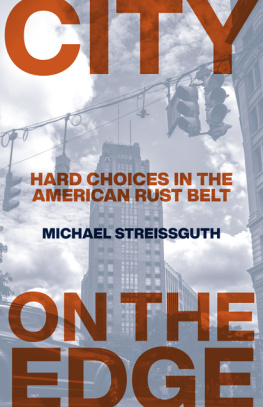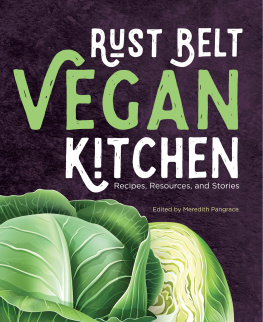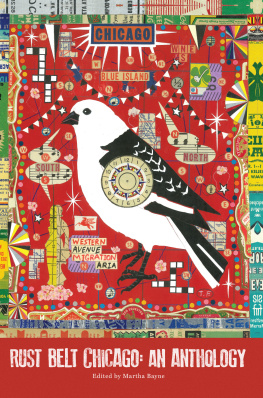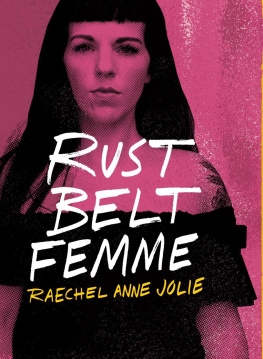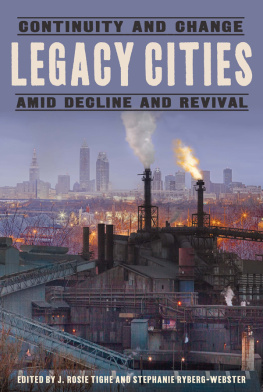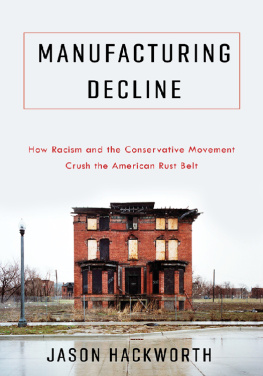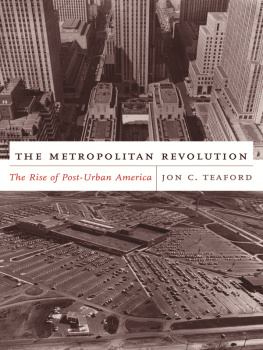Cover: The State Tower building in Syracuse.
Photograph 2020 Jordan Harmon
Published by State University of New York Press, Albany
2020 Michael Streissguth
All rights reserved
Printed in the United States of America
No part of this book may be used or reproduced in any manner whatsoever without written permission. No part of this book may be stored in a retrieval system or transmitted in any form or by any means including electronic, electrostatic, magnetic tape, mechanical, photocopying, recording, or otherwise without the prior permission in writing of the publisher.
Excelsior Editions is an imprint of State University of New York Press
For information, contact State University of New York Press, Albany, NY
www.sunypress.edu
Library of Congress Cataloging-in-Publication Data
Names: Streissguth, Michael, 1966 author.
Title: City on the edge : hard choices in the American rust belt / Michael Streissguth.
Description: Albany : State University of New York Press, 2020. | Series: Excelsior editions | Includes bibliographical references and index.
Identifiers: LCCN 2019037042 | ISBN 9781438479903 (paperback) | ISBN 9781438479897 (ebook)
Subjects: LCSH: Syracuse (N.Y.)History. | Syracuse (N.Y.)Biography. | Syracuse (N.Y.)Social conditions. | Syracuse (N.Y.)Economic conditions. | DeindustrializationNew YorkSyracuse. | DeindustrializationLake StatesCase studies.
Classification: LCC F129.S8 S733 2020 | DDC 974.7/66dc23 LC record available at https://lccn.loc.gov/2019037042
10 9 8 7 6 5 4 3 2 1
ACKNOWLEDGMENTS
More than 20 years ago, my wife and I came to Syracuse with our two-year-old daughter and another daughter six weeks away from delivery. A growing family will help you get to know a community and, sure enough, we met neighbors who were also parents and they introduced us to others around the city. Soon, there were church and nursery school and then elementary school to expand our social circles. The people in our neighborhood, those beguiling West Siders, became our Syracuse.
But even after two decades I really didnt know the half of it. I understood Syracuse community life was great and its mild summers couldnt be beat, and I accepted the irksome things, like unfocused economic development and the ninja motorcyclists who kicked up turf in our city parks. And I still often felt more like a Washingtonian than a Syracusan, resisting the unrelenting snows and never really understanding the allure of salt potatoes. So I wrote this book as a kind of submission to the city, accepting finally that Syracuse blood flowed in my veins.
This deep dive into my adopted hometown revealed the Syracuse Five: Stefon Greene, Elise Baker, Jessi Lyons, Justo Triana, and Neil Murphy. Three years later, I thank them for helping me to better understand how life courses through a city when it can seem to a cynic a static thing. They never shied away from hard questions and gave generously of their time. Much of that time was spent in the citys coffee shops, the real idea incubators in Syracuse, so thanks to Caf Kubal, The Broadway Caf, and Salt City Coffee.
Early drafts of this book were burdened by my blustery criticism of careless state policies and leadership, local indecision about the future of the I-81 highway, and developers who suck up tax breaks mostly for hotels that do little for economic development. There may still be a book to be written about those plagues, but my subjects didnt really care about them. Instead, they focused on what theynot political leaderscould do as individuals to build a bridge to the future. That was the yellow signal flag they raised in Syracuse, and I feel fortunate to have finally seen it.
My deep gratitude also goes to other interviewees: Debra Mims, Maurice Hoston, Rob Hoston, Trevor Russell, Brandon Baker, and Jasenko Mondom.
So many others have shown me their Syracuse and influenced my thinking about the city. At the top of the list are Edward and Carolyn Brown, with whom my wife, Leslie, and I have spent countless hours discussing urban life and our place in it. And theres Sean Kirst, the citys foremost writer and another coffee partner, whose work at the (Syracuse) Post-Standard and the Buffalo News , and in numerous books, has helped readers better understand what it means to live in New Yorks upstate cities, bearing witness to the nobility of this region.
Le Moyne College, my employer for as long as Ive lived here, has been another pathway to the city. Earlier in the decade, President Linda Le-Mura, then provost, asked me to be a dean for one year, which pushed me to many forums where the schools and the citys interests intersected, and Ive joyfully tracked many former students who have chosen to live and work here. Indeed, Le Moynein the shadow of Syracuse Universityis a driver in these parts. Thanks also to the colleges Research and Development Committee, which approved the sabbatical that allowed me to complete this book.
Im particularly indebted to Amanda Lanne-Camilli, Jenn Bennett-Genthner, and James Harbeck at SUNY Press, and Dr. Micki Pulleyking, who invited me to the 2018 Public Affairs Conference at Missouri State University, where I met colleagues who were essential to the life of this book.
Many thanks to my neighbors throughout the Strath more neighborhood. And to Maureen and Ozzie Mocete, Mary Jo and Jim Spano, J. B., Joe Kelly who continued to ask, Fernando Diz who championed edge over moments, Chris and Gretchen Kinnell, Adam Sudmann of My Lucky Tummy, Peter Willner, Fr. Fred Mannara, Sarah and Masih Robin, Jamie Cunningham, Angela Locke and Astrid Choromanska of the West Side Learning Center, Mike Woods, Jay Subedi, Rai Thetika, Naureen Greene, Mike Melara of Catholic Charities of Onondaga County, Sarah Kozma at the Onondaga Historical Association, Steven Featherstone, Wayne Stevens, Dan Roche, Dave Smetters, Phil Novak, Martin Goettsch, Jordan Harmon, Julie Grossman, Bryan Cole, Fr. David McCallum, Jim Hannan, James Joseph, Fr. Joe Marina, Ann Ryan, Kate Costello-Sullivan, Shawn Ward, Farha Ternikar, Josefa Alvarez, Melissa Short, Jeanne Darby, and David Lloyd.
And my eternal thanks to the home team: Leslie, Emily, Cate, and Will.

